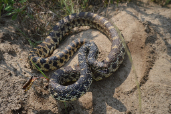|
Bullsnake (Pituophis catenifer sayi)
Description: Adult bullsnakes average about 4 to 6 feet in length, and specimens of up to 8 feet 4 inches have been recorded. Possibly being the largest subspecies of gopher snake on average, mature specimens can have an average weight in the range of 2.2–3.3 lbs., though the heavier known specimens can attain 7.9–9.9 lbs., with larger specimens being quite bulky for a colubrid snake. This makes bullsnakes among the largest snakes native to Canada and the United States, although they are generally not as long as indigo snakes nor as heavy or as large in diameter as rattlesnakes. They are usually yellow, with brown, white, black, or sometimes reddish blotching. The blotching pattern is large blotches on top, three sets of spots on the sides, and bands of black on the tail. Many color variations have been found, including albinos and white varieties. A scale count is required to distinguish juvenile bullsnakes from other juvenile gopher snakes.
Habitat: This species occurs in a wide range of habitats, extending from lowlands to mountains: desert, prairie, shrubland, woodland, open coniferous forest, farmland, and marshes. Midwestern populations inhabit prairies; western and Mexican populations range from coastal grasslands and forests through deserts into montane forests. This snake is terrestrial, fossorial, and arboreal. It remains underground in cold weather and during the hot midday period in summer; it may occupy mammal burrows or dig its own burrow, aided by the pointed snout and enlarged rostral scale. Is has been estimated that burrowing Pituophis could move up to 3,400 cubic cm of soil in an hour.
Range: The bullsnake (Pituophis catenifer sayi) occurs throughout the Great Plains and parts of the Midwestern United States, ranging from southern Saskatchewan, and Alberta, Canada south, into Nuevo Leon and Tamaulipas, Mexico. States in the USA include Colorado, Illinois, Indiana, Iowa, Kansas, Minnesota, Missouri, Montana, Nebraska, New Mexico, North Dakota, Oklahoma, South Dakota, Texas, Wisconsin, and Wyoming.
Diet: Bullsnakes are very powerful constrictors that eat small mammals, such as mice, moles, rats, pocket gophers, ground squirrels, as well as ground-nesting birds, birds' eggs and lizards. Their climbing proficiency enables them to raid bird nests (and birdhouses) to eat the nestlings or sitting mother. One snake can eat five small birds within 15 minutes. Juvenile bullsnakes depend on small lizards, frogs, and baby mice.
Reproduction: Bullsnakes breed in March or April (depending upon their location) and usually lay their eggs in April, May, or June (again, depending upon when the snakes breed.) They typically lay 12 eggs in sand or other protected areas and leave the eggs to incubate unprotected. Clutches of five to 22 eggs have been observed. The eggs are elliptical, leathery, rough, sticky, and up to 2+3/4 inches long. The eggs typically hatch in August or September. Baby bullsnakes are 7.9 to 18.1 inches at hatching. Their color is grayish until after their first shed. Eggs are deposited in burrows excavated by the female in loose soil, in spaces beneath large rocks or logs, or possibly in small mammal burrows.
Status: Listed as Least Concern in view of the large and relatively stable extent of occurrence, area of occupancy, number of subpopulations, and population size. No major threats exist.
»» Kingdom: Animalia - Animals
»» Phylum: Chordata - Chordates
»» Subphylum: Vertebrata - Vertebrates
»» Class: Reptilia - Reptiles
»» Order: Squamata - Scaled Reptiles
»» Suborder: Serpentes
»» Superfamily: Colubroidea
»» Family: Colubridae - Colubrids
»» Genus: Pituophis
»» Species: Pituophis catenifer - Gopher Snakes
»» Subspecies: Pituophis catenifer sayi - Bullsnake
This article uses material from the Wikipedia article "Bullsnake", which is released under the Creative Commons Attribution-Share-Alike License 3.0. Content may have been omitted from the original, but no content has been changed or extended.
|
|












